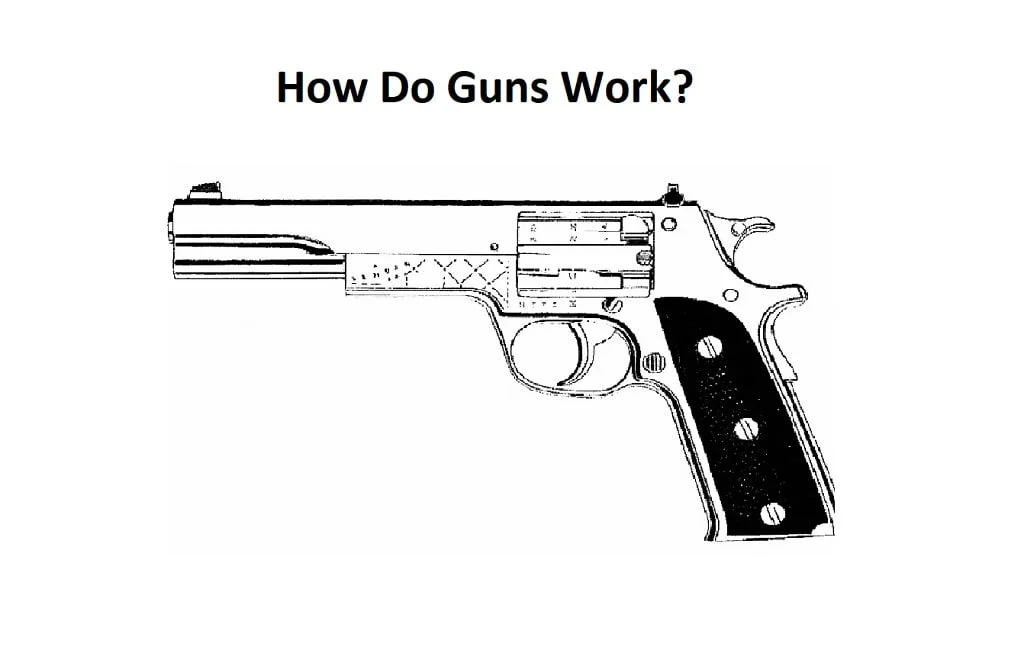
Table of Contents
Firearms have played a significant role in human history, serving purposes ranging from self-defense to sport shooting. Understanding how guns work is crucial for safe and responsible firearm ownership. In this article, we will delve into the mechanics behind firearms, explaining the essential components and the processes that enable them to function.
When the firearm is fired, the bullet travels through the barrel, which is a long metal tube. It contains spiral grooves called rifling that impart spin to the bullet, stabilizing its flight.
The action is the mechanism that loads, fires, and extracts cartridges. It encompasses several parts, including the bolt, slide, or cylinder, depending on the type of firearm.
The trigger is a lever that initiates the firing process when pulled. It releases the hammer or striker, causing it to impact the firing pin, which then ignites the primer in the cartridge.
The magazine is a container that holds cartridges and feeds them into the firearm’s action. It can be detachable or integral, depending on the firearm design.
The grip or stock provides a handle for the shooter to hold and stabilize the firearm. It houses the trigger and often contains the magazine well or ammunition storage.
The shooter loads the firearm by inserting a loaded magazine into the magazine well and chambering a round. This process varies depending on the firearm type.
Cocking the firearm prepares it for firing. In manual firearms, this involves manually pulling back the slide or hammer. In semi-automatic firearms, the cycling action typically cocks the firearm automatically.
The shooter aligns the firearm’s sights with the target to achieve proper aim. This involves aligning the front and rear sights and ensuring they are in focus.
When the shooter squeezes the trigger, it releases the hammer or striker, which strikes the firing pin. The firing pin then ignites the primer in the cartridge, igniting the propellant.
People can fire pistols with one hand as they are designed to be handheld firearms. They come in various configurations, including single-shot, revolvers, and semi-automatic pistols.
Rifles are long-barreled firearms designed to be fired from the shoulder. They offer increased accuracy and longer effective ranges compared to handguns.
Shotguns are firearms designed to fire a pattern of multiple projectiles called shot. They are versatile and used for various purposes such as hunting, sport shooting, and self-defense.
In single-action firearms, pulling the trigger performs a single action: releasing the hammer or striker.
Double-action firearms have the ability to perform two actions simultaneously with a single trigger pull. These actions include both cocking the hammer or striker and releasing it.
Semi-automatic firearms utilize the energy generated by firing a round to cycle the action, simultaneously extracting the spent casing and loading a fresh round from the magazine.
Bolt-action firearms, characterized by the manual manipulation of a bolt, are frequently utilized in precision shooting and hunting due to their inherent reliability and accuracy.
Pump-action firearms, commonly found in shotguns, utilize a sliding pump mechanism to cycle the action and chamber a new round.
Ammunition consists of a cartridge, which contains the bullet, propellant, primer, and casing. The bullet is the projectile fired from the firearm.
When the firing pin strikes the primer, it creates a small explosion that ignites the propellant inside the cartridge case.
As the propellant ignites, it generates rapidly expanding gas, which in turn propels the bullet down the barrel and out of the firearm.
When the shooter squeezes the trigger, the firing pin strikes the primer, igniting the propellant and firing the bullet.
Once the bullet exits the barrel, the firearm’s action initiates unlocking, enabling movement and preparation for the next round.
The chamber extracts the empty or spent casing, preparing it for a new round.
The firearm actively ejects the extracted casing through an ejection port, effectively clearing the way for the next round to be loaded.
The action of the firearm cocks the hammer or striker, preparing it for the next trigger pull.
Afresh round is fed into the chamber from the magazine or a new cylinder position, ready for the next firing cycle.
The new round is fully seated and locked into the chamber, positioning it for firing when the trigger is pulled.
Firearms incorporate various safety mechanisms to prevent accidental discharges and enhance user safety. Some common safety features include:
Regular cleaning and maintenance are essential for firearm longevity and optimal performance. The process involves:
Disassembling the firearm into its major components for cleaning, inspection, and maintenance.
Thoroughly cleaning the barrel, action, and other parts with appropriate cleaning solvents, and subsequently lubricating them, is essential for ensuring smooth operation.
Examining the firearm for wear, damage, or any issues that require attention. Performing function tests to ensure proper operation before reassembling the firearm.
Understanding how guns work is fundamental to safe and responsible firearm ownership. By familiarizing yourself with the components, firing mechanisms, ammunition, and safety features, you can develop a comprehensive understanding of firearms. Remember to always prioritize safety, follow local laws and regulations, and seek proper training and guidance when handling firearms. Responsible firearm ownership entails ongoing education, regular practice, and a commitment to safety at all times.
If you’re new to hunting or target shooting, choosing the right rifle scope can feel…
If you're out bowhunting, you know that estimating yardage isn’t just helpful it’s essential. A…
Table of Contents Introduction Gun ownership laws and regulations in the United States vary from…
For hunters and shooting enthusiasts, having a secure and organized way to transport firearms is…
When the hunting season approaches, every serious bowhunter knows: your bow isn’t just gear it’s…
Night vision gear is a critical tool for shooters, hunters, wildlife observers, and tactical operators.…
This website uses cookies.